Monstera plants, also known as Swiss Cheese plants, are popular indoor plants known for their unique, hole-filled leaves. Over time, dust and debris can accumulate on the surface of these leaves, which can interfere with photosynthesis and transpiration, ultimately affecting the health and beauty of your plant. Understanding how to clean monstera leaves is crucial for maintaining both their natural beauty and overall well-being.
Cleaning your monstera leaves is an important part of your regular plant care routine. Depending on various factors such as the location and level of air pollution, you may need to clean leaves more or less frequently. Although there are several methods to clean monstera leaves, it’s essential to choose the right method and cleaning agent to ensure the plant’s health and safety.
Key Takeaways:
- Regular cleaning of monstera leaves is vital for maintaining their health and appearance
- Different methods and cleaning agents can be used depending on your specific situation
- Be mindful of pests and post-cleaning care to optimize monstera leaf maintenance.
Understanding Monstera Leaves
Monstera leaves are the large, distinct leaves of the Swiss Cheese Plant, which is scientifically known as Monstera deliciosa. This popular houseplant is characterized by its fenestrations, which are the natural holes or slits found in the leaves. The unique fenestration has earned the plant its nickname, Swiss Cheese Plant. In this section, you will gain a deeper understanding of Monstera leaves and how they contribute to the plant’s overall health and growth.
The Swiss Cheese Plant is native to Central and South America, thriving in tropical forests where it climbs up trees in search of sunlight. The fenestration in Monstera leaves serves an essential purpose in its natural habitat. The holes and slits in the leaves help reduce wind resistance and allow sunlight to reach the lower parts of the plant. This adaption makes your Monstera an excellent indoor plant, as it can adapt to the light conditions inside your home.
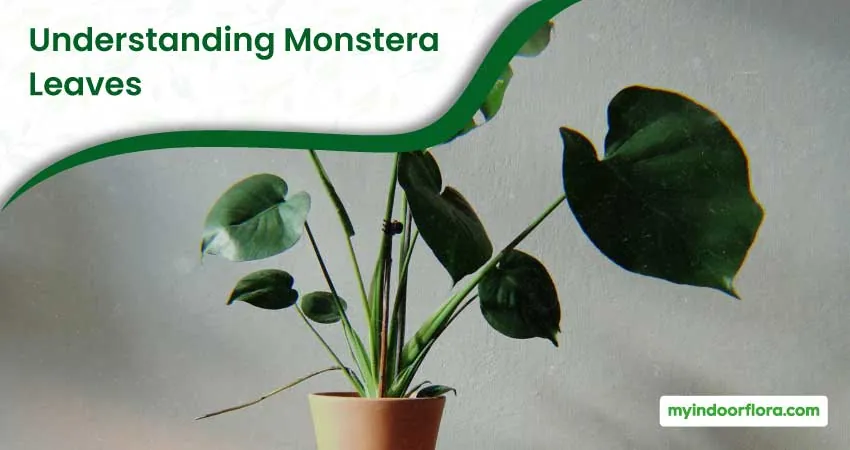
Monstera deliciosa is known for its dramatic, bold foliage. The leaves start small and heart-shaped, and they mature into larger, more fenestrated leaves as the plant grows. A healthy Monstera plant will produce vibrant, glossy leaves that are deep green in color. Proper care and attention to your Monstera, including regular cleaning of the leaves, will help ensure a thriving, beautiful plant.
Taking care of your Monstera leaves involves maintaining their cleanliness and monitoring their overall health. Cleaning the leaves not only helps them look more attractive, but it also allows the plant to photosynthesize efficiently and prevents pests from settling. Dust and grime can accumulate on the leaves over time, which interrupts important processes such as photosynthesis and transpiration. Keeping the leaves clean will support their essential functions and contribute to a healthy, happy Swiss Cheese Plant.
Why Clean Monstera Leaves
Cleaning Monstera leaves regularly is essential for several reasons. Firstly, it helps maintain the overall health and appearance of your plant. Like any other indoor plant, Monstera leaves are prone to collecting dust and debris on their surface. This dust buildup can hinder your plant’s ability to perform optimal photosynthesis.
Photosynthesis is the process by which plants convert sunlight into energy. When the leaves of your Monstera are covered in dust, it reduces their ability to absorb sunlight and conduct photosynthesis. Regular cleaning of the leaves ensures they can receive adequate sunlight and remain healthy.
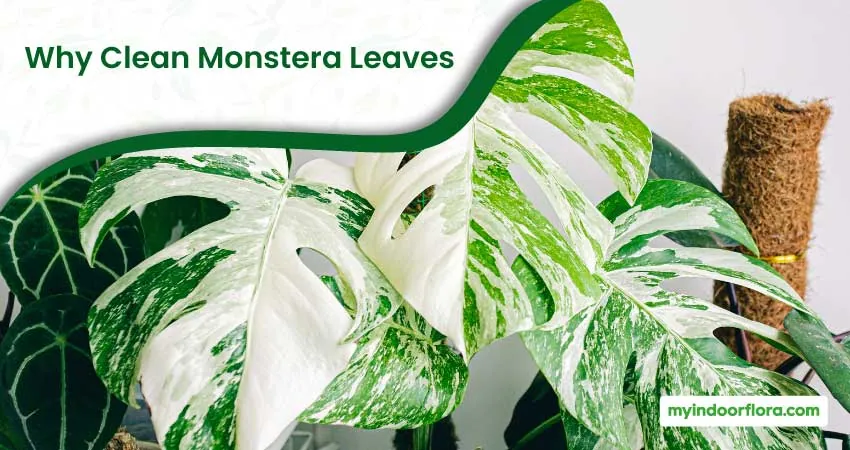
Another reason to clean Monstera leaves is to promote proper transpiration. Transpiration is the process by which moisture is evaporated from the leaves, allowing the plant to take in more water and nutrients from the soil. Clean leaves enable your Monstera to conduct transpiration effectively, ensuring that it remains hydrated and well-nourished.
Lastly, keeping the leaves free of dust and debris also helps prevent the growth of mold and mildew on your Monstera. Excess moisture and debris can create a favorable environment for fungal growth, which can pose a threat to your plant’s health and well-being.
By regularly cleaning your Monstera leaves, you not only maintain their visual appeal, but you also contribute to their overall health and vitality.
Preparing to Clean Monstera
Before you begin cleaning your Monstera plant, it’s essential to gather the necessary tools and supplies that will help you clean the leaves gently and effectively. Your goal is to maintain the plant’s health and appearance while minimizing any potential damage to the leaves. Here are the items that you should have on hand:
- Soft-bristled brush: A soft-bristled brush will help you remove dust and debris from the surface of the leaves without scratching or damaging them.
- Soft cloth: A soft cloth, preferably made from microfiber material, will be useful for gently wiping the leaves, picking up dust and dirt without causing any harm.
- Damp cloth: A damp cloth is essential for situations when you need a bit more moisture to loosen up stubborn grime on the leaves of your Monstera plant.
- Baby wipes: Natural baby wipes can provide an all-in-one solution for cleaning Monstera leaves, as they offer the right balance of moisture and gentle cleaning agents.
- Water and gentle dish soap solution: Mixing a few drops of gentle dish soap in warm water will create a gentle cleaning solution that you can use alongside your soft cloth.
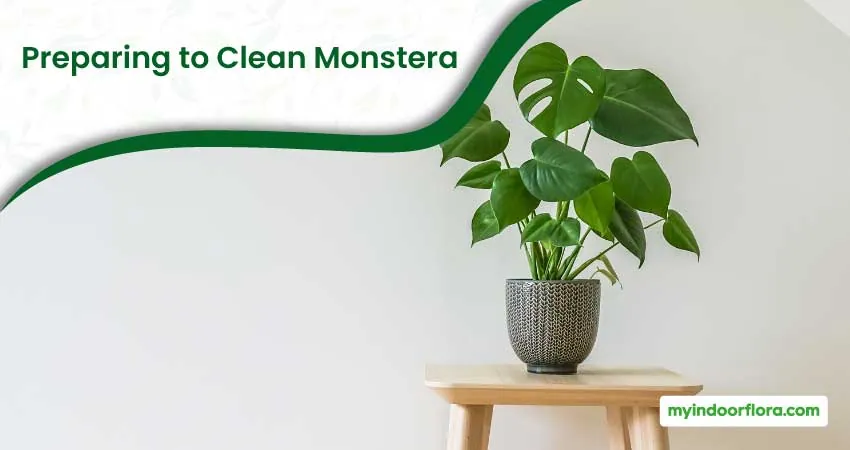
Once you have gathered these materials, it’s time to prepare your Monstera plant for cleaning. Follow these steps to ensure a smooth and efficient cleaning process:
- Move the plant: Move your Monstera plant to a well-lit, stable surface where you can easily access it for cleaning. This will help you work comfortably and minimize the risk of accidents, such as knocking the plant over.
- Inspect the leaves: Before you start cleaning, take a moment to inspect the leaves of your Monstera plant, looking for any signs of damage or infestation. Identifying these issues early on can help you address them promptly and prevent further damage.
- Decide on the cleaning method: Based on the size of your Monstera plant and the condition of its leaves, select the appropriate cleaning method for your situation. Smaller plants may benefit from gentle wiping with a soft cloth or baby wipes, while larger plants may require a more intense approach, such as rinsing, dunking, or spraying the leaves.
With your supplies ready and your Monstera plant prepared, you can now begin the process of cleaning its leaves. Keep a confident, knowledgeable, and clear approach throughout the cleaning process to ensure the best results for your Monstera plant. Remember to handle the leaves with care, and you’ll soon have a healthy, vibrant addition to your indoor living space.
Methods of Cleaning Monstera Leaves
Cleaning Monstera leaves can be done using several methods, depending on the size of your plant and the level of dust or grime. Regardless of the method you use, it’s important to be gentle with your plant to avoid causing any damage.
1. Soft-Bristled Brush Method:
Utilize a soft-bristled brush, such as a paintbrush or makeup brush, to gently sweep across the surface of each Monstera leaf.
This method is particularly effective for removing loose dust and debris without causing any abrasions or scratches on the leaf surface.
Make sure to brush both the top and underside of the leaves for thorough cleaning.
2. Cloth and Mild Soap Method:
Prepare a bowl of water mixed with 2-3 drops of mild dish soap. Dip a soft, lint-free cloth into the mixture and wring it out to remove excess water. Gently wipe each leaf, paying special attention to areas with visible grime or sticky residues.
This method is effective for more stubborn dirt but requires careful handling to avoid tearing or damaging the leaves.
3. Sink Rinse Method for Small Plants:
For smaller Monstera plants, the kitchen sink provides an ideal setting for a quick rinse. Use lukewarm water to avoid shocking the plant and aim the faucet’s spray nozzle directly at the leaves. Gently manipulate the leaves under the running water to ensure that both the upper and lower surfaces are free from dust and grime.
4. Dunking Method for Medium Plants:
Fill a large bucket or basin with room-temperature water. Carefully lower your medium-sized Monstera plant into the water, ensuring that only the leaves are submerged. Gently agitate the water to dislodge dust and any lurking pests.
This method is effective but should be done cautiously to prevent water from saturating the soil, which could lead to root rot.
5. Misting Method:
Create a misting solution by adding 2 drops of mild dish soap to a spray bottle filled with water. Lightly mist the leaves, ensuring even coverage.
This method not only removes dust but also helps to increase the ambient humidity around the plant, which is beneficial for Monstera growth.
However, avoid excessive misting as it can lead to moisture-related issues like fungal growth.
6. Compressed Air Method:
If the soil is already moist and you want to avoid additional water, a can of compressed air can be a useful tool. Hold the can approximately 10 cm away from the leaves and use short bursts to dislodge dust and debris.
This method is quick and effective but should be used cautiously to prevent damaging the delicate leaves.
7. Hosing or Shower Method for Large Plants:
For larger Monstera plants, an outdoor hosing can be effective. Use a hose with a gentle spray setting to avoid damaging the leaves.
If cleaning indoors, placing the plant in the shower is an alternative. Run lukewarm water over the plant for several minutes, ensuring that all leaves are rinsed.
After either method, allow the plant to drain thoroughly before returning it to its usual location to prevent waterlogged soil conditions.

Overall, maintaining the cleanliness of your Monstera leaves will contribute to the plant’s health, prevent pest infestations, and promote efficient photosynthesis. Choose the cleaning method that best suits your plant’s size and specific situation for optimal care.
Use of Cleaning Agents for Monstera Leaves
When it comes to cleaning Monstera leaves, there are a variety of cleaning agents you can use to effectively remove dirt, dust, and grime. By choosing the right cleaning solution and carefully applying it to your Monstera leaves, you can help maintain the health and appearance of your plant.
Water is the simplest and most commonly used cleaning agent for Monstera leaves. You can use plain water or tepid water, making sure it’s neither too hot nor too cold. Rinse the leaves under a gentle stream of water or dunk them in a bucket of water, ensuring they are evenly and thoroughly cleaned.
Mild liquid soap and dish soap can also be used, but it is important to dilute them first to avoid damaging the plant. Mix a few drops of soap with water in a spray bottle, then mist the leaves and wipe them gently with a soft cloth. Rinse the leaves with plain water afterwards to remove any soap residue.
For a natural cleaning solution, you can use diluted vinegar or milk to clean Monstera leaves. Mix equal parts of water and vinegar or milk, then apply the solution to the leaves using a soft, damp cloth. Gently wipe down the leaves, then rinse them with water to remove any remaining cleaning agent.
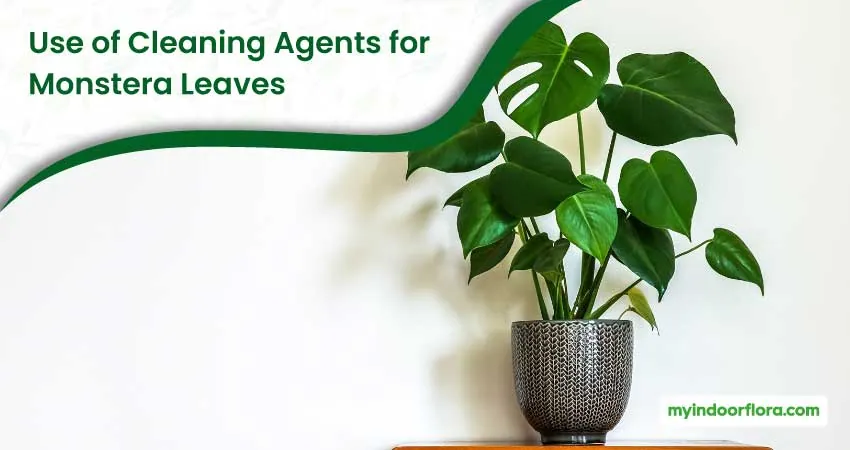
Neem oil is another excellent option as it not only cleans the leaves, but also provides a natural pest deterrent. Mix a few drops of neem oil with water in a spray bottle and apply it to the leaves. Gently rub the solution over the surface, then rinse the leaves with water.
If you prefer a more natural shine for your Monstera leaves, diluted olive oil or coconut oil can also be used. Mix a small amount of oil with water, then apply the solution to the leaves with a soft cloth. Gently buff the leaves to bring out their natural shine. Be sure to use oil sparingly to avoid clogging the leaf pores.
While there are numerous commercial leaf shine products available, it is crucial to read the labels and ensure they are safe for use on Monstera plants. Some leaf shine products may contain chemicals that could harm the plant. If using such a product, follow the manufacturer’s instructions carefully.
Regardless of the cleaning agent you choose, be gentle when wiping the Monstera leaves to prevent damage, and always test the solution on a small, inconspicuous area of the plant first. By following these guidelines, you can confidently and effectively clean your Monstera leaves, keeping them healthy and vibrant.
Dealing with Pests and Diseases
As a Monstera plant owner, it’s essential to routinely check your plant for signs of pests and diseases. Some common pests that can infest your Monstera include spider mites, mealybugs, aphids, thrips, and fungus gnats.
On the other hand, diseases that can affect your Monstera include root rot, bacterial leaf spot, and powdery mildew. To prevent and treat these issues, follow these simple steps.
- Inspect your plant regularly. Keep an eye out for any symptoms of infestations, such as honeydew (a clear, sticky goo) or leaves turning yellow and wilting. Detecting these signs early will help control the problem before it becomes severe.
- Apply neem oil. Neem oil is a natural and effective solution for dealing with pests such as spider mites, mealybugs, and aphids. Mix a few drops of neem oil in a spray bottle with water and apply it to the affected areas of your Monstera. The key is to be consistent and persistent – reapply it every few days until the pests are gone.
- Avoid overwatering. Overwatering is a common mistake, which can lead to root rot, a fungal disease that causes the roots to rot and die. To prevent this, maintain a proper watering schedule according to your Monstera’s needs. Remember to let the soil dry out between waterings and use a well-draining potting mix.
- Use biological control. For some pests, like fungus gnats, introducing beneficial organisms can help keep them at bay. These organisms often feed on the pests and help to maintain a balance in the plant’s ecosystem.
- Prune affected areas. If you notice any leaves or stems showing signs of disease or pest infestation, prune them off to prevent the issue from spreading. Dispose of the affected parts properly to avoid reintroduction of the problem.

By following these steps and maintaining a healthy environment for your Monstera, you can effectively deal with pests and diseases and enjoy a thriving, beautiful plant.
After Cleaning Care for Monstera
Caring for your Monstera after cleaning its leaves is crucial for the plant’s overall health. Pay attention to the following factors for a thriving Monstera in your space.
- Consistent Watering Schedule: After cleaning, it’s important to maintain a regular watering routine. Water your Monstera when the top inch of the soil feels dry to the touch. This practice helps in avoiding both underwatering and overwatering, which can lead to root rot. Make sure the pot has proper drainage holes to allow excess water to escape.
- Sunlight Exposure Monitoring: Place your Monstera in a location where it can receive bright, indirect light. Direct sunlight exposure for extended periods can scorch the leaves, causing irreversible damage. After cleaning, it’s a good time to assess the plant’s current light conditions and make any necessary adjustments.
- Humidity Level Maintenance: Monstera plants thrive in humidity levels between 60% and 80%. Achieve this by using a humidifier or by placing the plant on a tray filled with water and pebbles. Misting the leaves can also help, especially during drier months. This is particularly important after cleaning, as the plant may have lost some moisture during the process.
- Routine Care Review and Adjustments: Regularly review your Monstera care routine to adapt to any changes in the plant’s growing environment. This is crucial after cleaning, as the plant may respond differently to its care regimen. Consistent monitoring and timely adjustments will ensure that your Monstera remains healthy and vibrant long after the cleaning process.
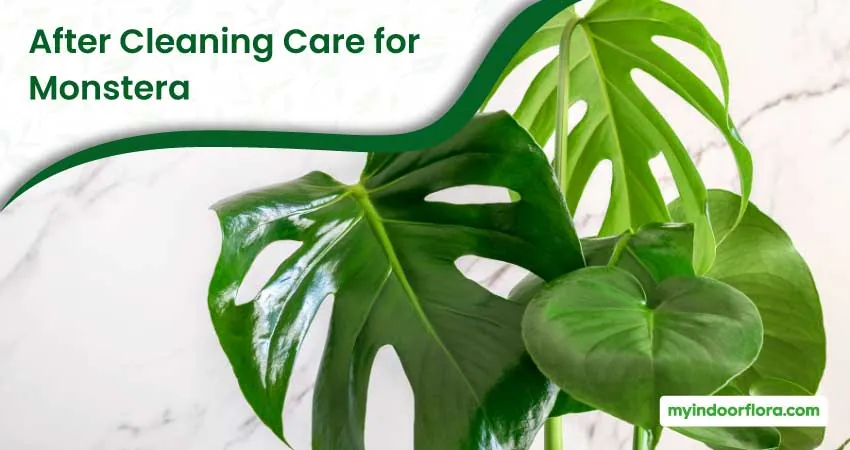
Follow these after cleaning care practices, and your Monstera will thrive.
Cleaning Frequency and Schedule
To maintain the health and appearance of your monstera plant, it’s essential to establish a regular cleaning schedule. Cleaning frequency for monstera leaves depends on various factors, including the environment your plant is in and the amount of dust or grime it accumulates.
In most cases, cleaning your monstera leaves once every two weeks or once a month should be sufficient. However, if your plant is placed in a particularly dusty area, you might need to clean the leaves more frequently, possibly once a week. The key is to observe how quickly dust and grime accumulate on your monstera and adjust its cleaning frequency accordingly.
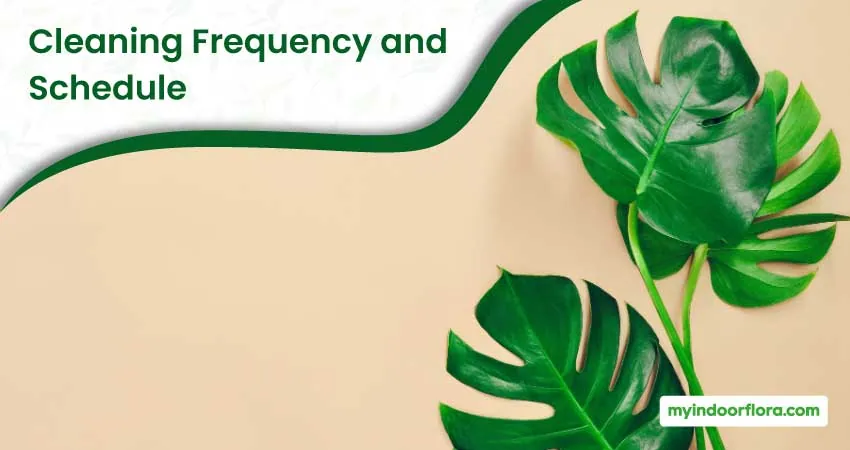
Establishing a cleaning schedule will not only maintain the plant’s appearance but also improve its overall health. Regular cleaning helps prevent the buildup of dust and grime, which can interfere with important plant processes like photosynthesis and transpiration. By cleaning the leaves regularly, you are ensuring that your monstera receives optimal sunlight and can perform its necessary functions.
While setting up your cleaning schedule, make sure to choose a method that’s gentle yet effective in removing dust and grime. Options include using a soft-bristled brush, a damp cloth, or a spray bottle with water. You could also use compressed air, give your monstera a gentle shower, or dunk smaller plants in a bucket of water. Choose a method that works best for your plant’s size and your specific situation.
Maintaining Monstera’s Natural Beauty
- Regular Leaf Cleaning: Keep the leaves dust-free to allow for efficient photosynthesis. Use gentle methods like wiping with a damp cloth or soft-bristled brush to maintain the natural shine and color of the leaves.
- Optimal Watering Practices: Water the plant when the top inch of soil feels dry, using room-temperature water. Overwatering can lead to root rot, while underwatering can cause the leaves to lose their luster.
- Bright, Indirect Light: Position your Monstera in a spot where it receives bright but indirect light. Direct sunlight can scorch the leaves, diminishing their natural beauty.
- Humidity Management: Maintain a humidity level between 60% and 80% for your Monstera. Use a humidifier or a pebble tray with water to achieve this. High humidity levels contribute to the lush, tropical appearance of the plant.
- Pruning and Leaf Trimming: Regularly prune dead or yellow leaves and trim back any unruly vines. This not only enhances the plant’s appearance but also encourages more vigorous growth.
- Fertilization: Use a balanced liquid fertilizer every 4-6 weeks during the growing season. Proper fertilization helps maintain the deep green color and promotes healthy leaf development.
- Pest Control: Regularly inspect for signs of pests like spider mites or aphids. Use organic insecticides or neem oil sprays as a preventive measure to maintain the plant’s natural beauty.
- Repotting: Repot your Monstera every 1-2 years or when it outgrows its current pot. Choose a pot that is 2-3 inches larger in diameter than the current one and has good drainage. Repotting rejuvenates the plant and provides it with the space it needs to grow beautifully.
- Leaf Support: Use stakes or a moss pole to support larger leaves and maintain the plant’s upright posture. This adds to the aesthetic appeal by giving the plant a well-structured look.
- Seasonal Adjustments: Be mindful of seasonal changes that can affect your Monstera’s appearance. Reduce watering in winter and consider using a grow light if natural light is limited.
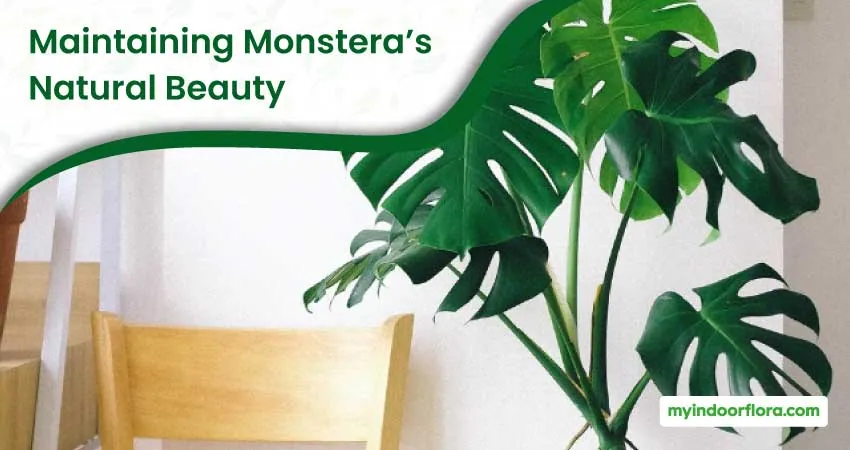
By following these practices, you can maintain the natural beauty of your Monstera, ensuring it remains a stunning focal point in your living space.
